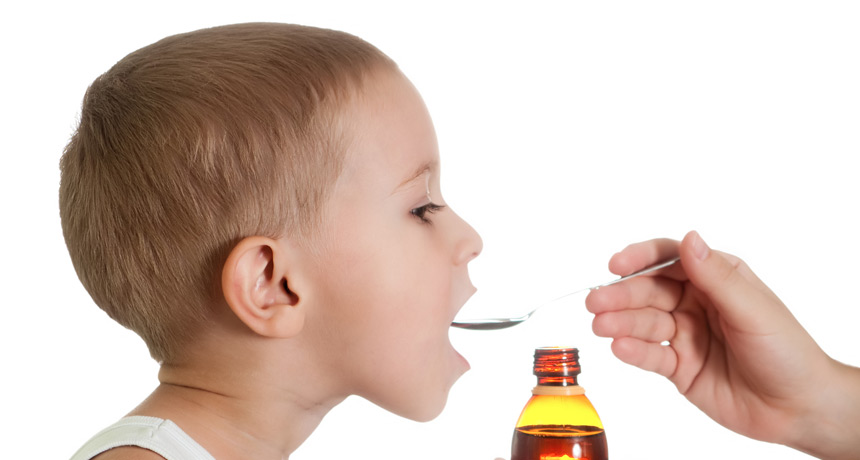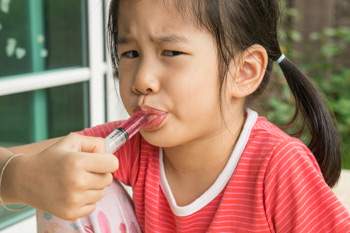Don’t use dinner-table spoons for liquid medicines!
Doctors explain why liquid medicines must be measured precisely — but often aren’t

This is no way to give medicines, especially to children. This tableware spoon is too imprecise to measure out liquids accurately.
ia_64 / iStockphoto
From ice cream to exercise, too much of a good thing can make people sick. And when people take too much medicine, the effect can be dangerous. That’s why doctors are concerned about the findings of a new survey.
Liquid medicines can be tricky to measure correctly. Doctors recommend measuring drugs with tools such as medicine droppers and oral syringes. They strongly prefer the use of these over such things as kitchen spoons. But recommendations are only helpful if people follow them. And many parents don’t, the new survey indicates.
Shonna Yin is a pediatrician at New York University in New York City. She was part of the team that studied how parents interpret the dosing instructions on labels for liquid medicines. Her team recruited 2,096 parents to take part. All had at least one child who was eight or younger.
The parents read the dosing label for a liquid medicine. They then selected the tool they would use to measure it. Many chose imprecise spoons from a flatware set.
The name “teaspoon” can apply to two types of spoons. A teaspoon for baking has a precise size. It always delivers the same amount of an ingredient. But the term is also given to a spoon that is part of a flatware set used for dining. These dinnerware teaspoons can vary widely in size. A parent who uses one of those spoons risks dispensing too much or too little medicine.
Yet plenty of parents are ready to do that, the new study found. The findings will appear in an upcoming issue of the journal Academic Pediatrics.
Spooning it out, by the numbers
The scientists recruited parents who had brought a child to one of three outpatient clinics. At least seven out of every 10 people visiting these clinics come from low-income households.

The parents were randomly divided into five groups. Each received dosing instructions for a liquid medicine. Two groups received labels that only had one unit on them: milliliters, abbreviated as mL. Parents in a third group were given labels that had two units. These were milliliters, abbreviated as mL, and teaspoons, abbreviated as “tsp.” Parents in a fourth group were given labels that had mL and “teaspoons.” Parents in the fifth group were given labels that only had one unit: teaspoons, spelled out.
The parents were shown a card with labeled photos of dispensing tools. These included dosing spoons, measuring spoons, dosing cups, droppers and oral syringes. Each had markings to help measure a dose accurately. Other photos showed flatware teaspoons and tablespoons — tools that cannot measure liquids accurately.
After looking at the card, the researchers asked each parent: “If you had all of these dosing tools at home, which of these would let you give your child the correct amount of medicine?”
Parents who were given labels with teaspoon units were most likely to choose a flatware spoon. This was the case even when the label also included a milliliter option. In all, more than one-quarter (27.7 percent) of parents who were given labels that contained teaspoon units chose a dinnerware spoon. In contrast, only 8.3 percent of parents in the groups given labels with just the milliliter units chose such an imprecise spoon.
Of parents given milliliter and “tsp” instructions, 22.2 percent chose a kitchen spoon. The share was even higher, 29 to 31.8 percent, among parents who had been given milliliter and “teaspoon” instructions or “teaspoon” only instructions.
How “health literate” are parents?
Parents’ health knowledge might affect their dosing choice. The researchers describe this understanding as “health literacy.” This term “has to do with how a person understands information about their health, and how they make decisions about their health using that information,” explains Yin.
More than three out of every four parents (77 percent) in the study didn’t score well on health literacy. And this group was less likely to pick an accurate measuring tool.
Doctors and other professionals can help parents understand how to measure medicines more precisely, the authors say. After all, the stakes for getting it right are high. “Kitchen spoons come in many different shapes and sizes,” notes Yin. “Reaching for the wrong size spoon could lead to someone giving more [medicine] than intended, or less.”
The new data support guidelines by the U.S. Centers for Disease Control and Prevention and the American Academy of Pediatrics. Both recommend that doctors and drug companies label dose information only in milliliter units.
The study also supports another recommendation made by the American Academy of Pediatrics, notes Ian Paul. He is a pediatrician at Penn State College of Medicine in Hershey, Pa. That group of doctors recommends “using syringes with metric units.”
What’s more, such a switch might help parents, who can become distracted when dealing with a sick child. They could misread tablespoons for teaspoons. Or they might confuse the number for this unit with the milliliter amount. Giving 2 tablespoons instead of 2 milliliters, Yin notes, would result in a child ingesting 15 times the labeled dose. A serious overdose could cause abnormal heart rhythms or even seizures, she points out.
“It’s important for kids to start learning about how to take care of their own health, even at a young age,” argues Yin. “That way, when they are on their own, away from their parents, they will know what to do to keep themselves healthy.”







